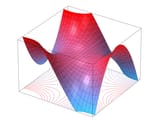Search Results
!!/7cMIiSCHvi/lit/24536636#24537416
7/10/2025, 5:39:42 PM
>>24530482
>>24532033
>>24536915
>>24536920
My story is about the origin of light—“the point” is the first (and only?) photon—it takes place before Judeo-Christian Creation.
Light is half-wave (half-“theory”), and, oppositely, half-particle (half-“solid”).
At the end, the photon meets God (AΩ, “Alpha and Omega”) and becomes the electromagnetic spectrum in our universe—“Fiat lux” means “Let there be light” in the Vulgate.
Each line is seperated/spaced to emulate such Bible verses, particularly in the way this website presents them (sans the translation):
https://www.sacredbible.org/studybible/NT-27_Revelation.htm
I was reading it the past month as a source for easy/reliable Latin-to-English, but the esoteric imagery stayed with me, I guess.
I wanted to create a piece whose knack for appreception (its readability) was hindered by abstruse content/terminology, rather than just its symbolism.
This sounds dumb, but the story is kinda designed to filter people, much like how you need to be “in the know” to understand what means what in Biblical Revelation.
I raided online geometry glossaries and went down some Wiki rabbit holes to get some of the terms—though “monkey saddle” I did get from a physical book’s index.
https://en.wikipedia.org/wiki/Monkey_saddle
I already knew abscissa and ordinate from Sanborn’s Kryptos statue, but applicate (the Z coordinate) I only found out about in my quick research here.
“Gemowe Lines” were the proto equals-sign.
https://en.wikipedia.org/wiki/Equals_sign
I doh’t think “Anularis” is a math term, but neither is AΩ—I wanted a bit of an exotic, truly un-understandable presence/character.
(Btw, “Anularis”/ring-shaped was meant to be “Anularius”/ring-maker, but I still suck at Latin and forgot the “u” after visiting Wiktionary, but same difference, lol.)
I also said “tensor product” (which looks like ⊗), but maybe the Anularis in that moment should have looked more upright, like a direct sum symbol (⊕)?
The character is basically doing an around-the-world yo-yo trick with the point to make (the first?) circle, which has infinite points crashing into themselves all along the curve—it’s this theory-density that created mass in their dimension.
>Why does it feel true that parallel lines are arrogant?
This exact sentiment of “arrogance” at impossible, unattainable perfection is something I got from Cixin Liu’s “Dark Forest” in his describing an absolutely smooth surface.
Thanks for reading, everyone.
It may take some time, but everyone will get a critique from me. Will vote tonight.
>>24532033
>>24536915
>>24536920
My story is about the origin of light—“the point” is the first (and only?) photon—it takes place before Judeo-Christian Creation.
Light is half-wave (half-“theory”), and, oppositely, half-particle (half-“solid”).
At the end, the photon meets God (AΩ, “Alpha and Omega”) and becomes the electromagnetic spectrum in our universe—“Fiat lux” means “Let there be light” in the Vulgate.
Each line is seperated/spaced to emulate such Bible verses, particularly in the way this website presents them (sans the translation):
https://www.sacredbible.org/studybible/NT-27_Revelation.htm
I was reading it the past month as a source for easy/reliable Latin-to-English, but the esoteric imagery stayed with me, I guess.
I wanted to create a piece whose knack for appreception (its readability) was hindered by abstruse content/terminology, rather than just its symbolism.
This sounds dumb, but the story is kinda designed to filter people, much like how you need to be “in the know” to understand what means what in Biblical Revelation.
I raided online geometry glossaries and went down some Wiki rabbit holes to get some of the terms—though “monkey saddle” I did get from a physical book’s index.
https://en.wikipedia.org/wiki/Monkey_saddle
I already knew abscissa and ordinate from Sanborn’s Kryptos statue, but applicate (the Z coordinate) I only found out about in my quick research here.
“Gemowe Lines” were the proto equals-sign.
https://en.wikipedia.org/wiki/Equals_sign
I doh’t think “Anularis” is a math term, but neither is AΩ—I wanted a bit of an exotic, truly un-understandable presence/character.
(Btw, “Anularis”/ring-shaped was meant to be “Anularius”/ring-maker, but I still suck at Latin and forgot the “u” after visiting Wiktionary, but same difference, lol.)
I also said “tensor product” (which looks like ⊗), but maybe the Anularis in that moment should have looked more upright, like a direct sum symbol (⊕)?
The character is basically doing an around-the-world yo-yo trick with the point to make (the first?) circle, which has infinite points crashing into themselves all along the curve—it’s this theory-density that created mass in their dimension.
>Why does it feel true that parallel lines are arrogant?
This exact sentiment of “arrogance” at impossible, unattainable perfection is something I got from Cixin Liu’s “Dark Forest” in his describing an absolutely smooth surface.
Thanks for reading, everyone.
It may take some time, but everyone will get a critique from me. Will vote tonight.
Page 1
